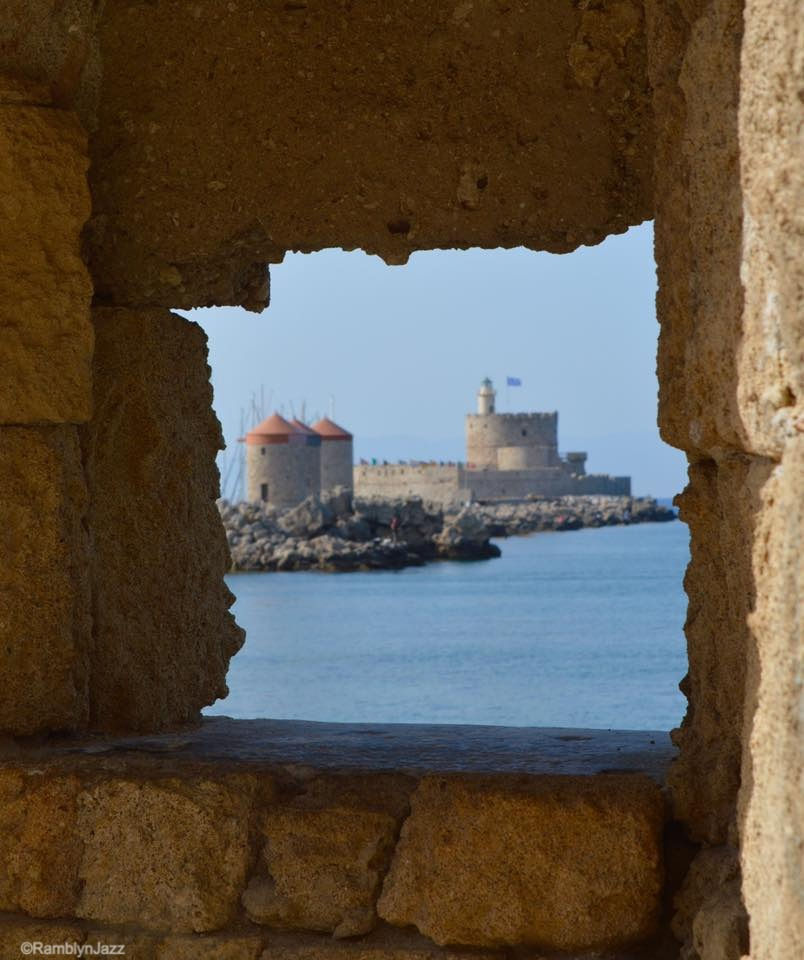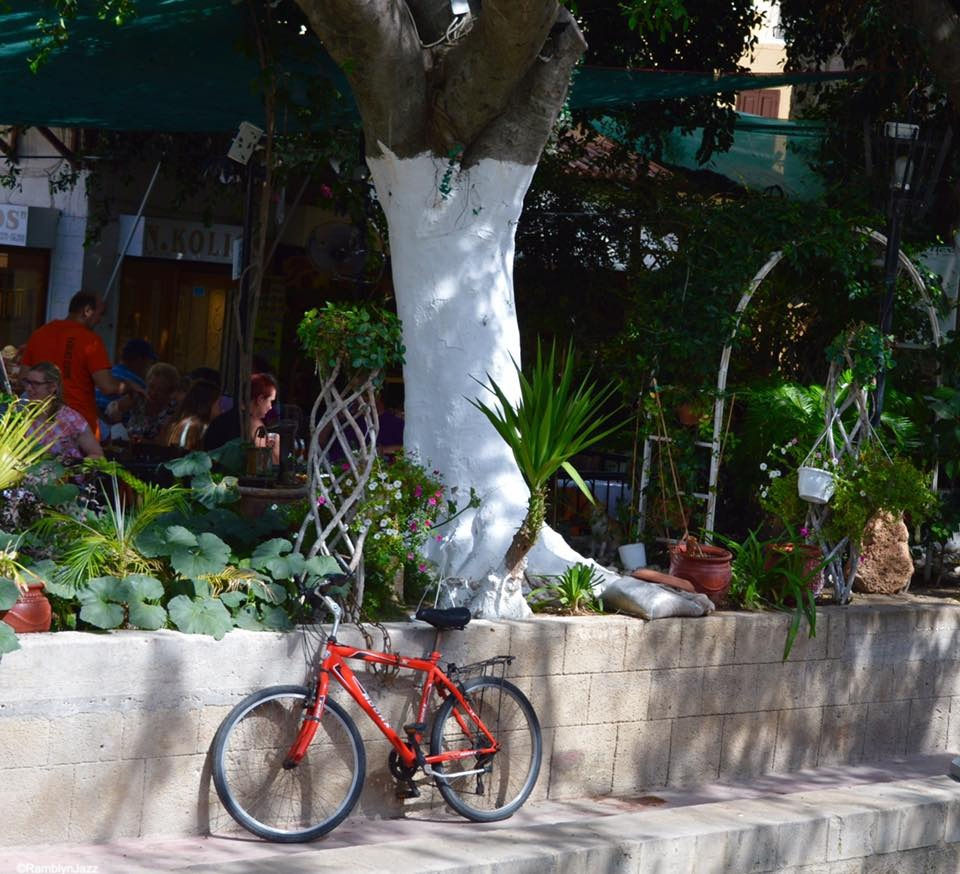Island Hopping in Greece: Rhodes
- Lyn (aka Jazz)

- Nov 14, 2022
- 6 min read
Most people envision the white-washed, blue-roofed buildings and the beautiful sandy beaches of the Cyclades when thinking about island hopping in Greece. It doesn't take long to realize that the island of Rhodes in the Dodecanese island group is very different. A UNESCO World Heritage site, Rhodes Old Town is one of Europe's most well-preserved medieval cities. It is lush and green, without the brilliant white reflecting in your eyes. Rhodes has an interesting history of fighting off invasions and then joining the invaders to fight off other invaders. Each group left their mark on the island and its people.

Because of its strategic position, Rhodes was conquered successively by Turks, Persians, and Saracens. The occupation by the Venetians in Medieval times was a time of great building when the Knights of Saint John turned the city into a fortress with the building of the Palace of the Grand Master.

The Ottomans took control of the island after a long siege in 1523 and remained in control until 1912 when Rhodes was occupied by the Italians until 1943. Finally, in 1947, Rhodes and all the other Dodecanese islands became part of the Greek State.

Not only is there an incredible military history but Rhodes has also been the birthplace of philosophers, politicians and artists. Mythological connections to Helios, the patron god of the island, and the famed Colossus of Rhodes weave through all historic tales and descriptions.

Meander Around Rhodes Town
One of the best ways to appreciate an old town is to simply meander. Rhodes is a very walkable town with many small streets and alleys to explore.

Rhodes Town is the main city and has two parts: the Old Town and the New Town. The Old Town is surrounded by thick walls with seven gates.

Most guide books recommend using Gate D'Amboise. We crossed the bridge over a large (dry moat) and through the Amboise Gate and along a gallery walk at the lower end of Orfeos (Orpheus) Street until we got to St. Anthony's Gate which leads into the town proper.


The town has a very different feel and architecture than our previous island stops. The Old Town is a product of its past with influences from Europe, the Middle East, and North Africa. There are many bars, restaurants, and souvenir shops but, tucked in between the tourist traps, there are some fabulous artisan shops.

We found the Island Lipsi restaurant, and were amused to note this sign which quoted from Canadian Traveller magazine (we agreed with everything on this sign).

The building is 450 years old, it had been a stable, a Turkish bath, and a reptile farm! It offered very tasty fresh, organic food. The freebie at the end of the meal included a shot of limoncello and a tasty orange cake with homemade ice cream.

In one of those "travel moments", ATB#1 and I were shopping for some sundresses and got to chatting with the shopkeeper, Katerina. It turned out that she was an amateur flute player but had not been able to play because both her flutes were broken and the closest repair shop was in Athens. I offered to return to the shop the following day to try to fix them. I spent at least 45 minutes and was able to repair one of the flutes enough to make it playable. Katerina was thrilled and I thoroughly enjoyed my time getting to know her and her sister.

The Street of the Knights
The Street of Knights, or Ippoton, is a medieval cobbled street that begins from the Port of Rhodes Town and ends at the Palace.

The Knights of the Crusades were divided into seven groups based upon their birthplace and language. Each language group was responsible for a different part of the fortress. Along this street were seven inns, one for each of the seven languages. Each inn is decorated with emblems and details reflecting their nations. All of the inns are well-preserved and are still functional. The Palace of the Grand Master
The most recognized sight in Rhodes Old Town is the Palace of the Grand Masters that once housed the Masters and the administrative center of the Knights of the Order of St. John.
Today, the ground floor is a museum which holds two large exhibits about the city of Rhodes.

The Palace is a huge stone palace built during the Byzantine era on top of the foundations of a temple dedicated to the God of the Sun. It is an imposing building with working areas on the ground floor and living and entertaining areas upstairs.

Tours of the Palace run daily between 08:00 and 20:00 for €6. If you wish to walk the walls, it can only be done Monday to Friday between noon and 15:00 for €2.

The Archeological Museum of Rhodes
The Archaeological Museum of Rhodes is inside the Hospital of the Knights. Construction was started in 1440 but wasn't completed until nearly fifty years later. Considered the best museum in the Dodecanese it includes ancient relics, urns, and statues from excavations all over Rhodes and other Dodecanese islands.

Different exhibits have different openings and schedules. Check their website when making plans but generally, summer hours (April - October) are from 08:00 - 20:00 (€6) and winter hours are from 08:00 - 17:00 (closed Tuesdays) at half the price. There is also a special 3 day ticket that can be used for the Palace of the Grand Masters, the Archaeological Museum, the church of Our Lady of the Castle, and the Decorative Arts Collection for €10.
Ippokratous Square
Ippokratous Square is the very busy main meeting point and coffee spot, located just inside the Marine Gate.

The Clock Tower
The 7th-century Clock Tower is the highest building in the Old Town, dating from 1852. The working clock was intended to keep track of Turkish time during their occupation.

Visitors can climb a steep wooden staircase to the top for €5. It is a narrow staircase with few landings and no room for passing other visitors. Be patient. The views are a challenge, however, with four small windows located around knee height. The entrance fee includes a free drink (beer, wine, soft drink, coffee) on the terrace below.
The Mosque of Suleiman the Magnificent
The most important mosque in Rhodes is the Mosque of Suleiman the Magnificent built in 1522 and reconstructed in 1808 to commemorate the victory of the Ottomans against the Knights. The mosque is octagonal with three domes and one large central dome. Although it has been closed to visitors since 2014, it can still be enjoyed from outside.

Nearby is the Mehmet Aga Mosque originally built in 1820, refurbished in 1875, and repaired in 1948. Th wooden minaret is its most striking feature.

The Ottoman Library
The small Hafiz Ahmed Agha Library opposite the Mosque of Suleiman, is an important Ottoman library founded in 1793. The library started with 1995 manuscripts and became a hub of learning with librarians teaching residents to read Arabic.

Today there are over 1250 manuscripts including a Koran from 1540, old maps, and a history of the Turkish siege of 1522.
The Lady of the Castle Cathedral
The Lady of the Castle cathedral is a Byzantine church dating from the 11th or 12th century and is known as Panagia tou Kastrou in Greek. This was the Roman Catholic cathedral but was used as a mosque during the Turkish occupation.

All the interior decoration has been lost, except for a few remnants of wall paintings. When Italy took over the town, the mosque was re-converted back into a Christian temple.
Holocaust Memorials
There are multiple memorials to the Jews of Rhodes. I think this sign at the Ancient Storehouse says it all. A very sobering reminder of the holocaust.


Rhodes Acropolis
The Acropolis of Rhodes is the acropolis or upper town of Ancient Rhodes dating back to the 5th century. It's about 3km from the center of New Town. We took a slow walk through very pleasant residential areas but there is also a public bus that stopped right at the main parking lot.

Like many Greek ancient sites, this is completely open and free to all visitors. Sadly, it has been neglected due to financing issues.

This archaeological park includes a 3rd-century Hellenistic stadium where athletic events took place during the Haleion Games. The stadium, built in 3BC. It is huge.

Beside the stadium is a small restored Odeon where events are still staged today. Along the street are the remains of the temple of Athena and Zeus.

At the summit of the Acropolis is the Pythion Apollo temple, honouring the patron god of the city. Reconstruction of the temple was begun by the Italians and then continued by the Greek Archaeological Service after the end of World War II to repair the damage caused by bombs and the weight of artillery emplaced there. Further restoration work was started in 1996. I'm not sure when they walked away from the restoration process but I suspect it was during the financial crisis. At least the scaffolding will prevent the temple from toppling.


There is little information available on site beyond a very few and difficult to locate plaques. The site is always open and does not charge a fee to visit.


The site may be a bit disappointing because of the lack of information but the panoramic views of the city and the sea are spectacular and the sunsets would be breathtaking.

Our time in Rhodes was too short. A full week would have allowed us to discover more of the island but we'll have to leave the rest for another trip.
Thanks for meandering with me! Leave me some feedback, or share your tips in the comments below. Send the link to a friend. Become a member to receive notifications of new content, access to our members' forum, and a monthly newsletter full of chatty behind the scenes news, useful travel hints and links, plus more!







Comments